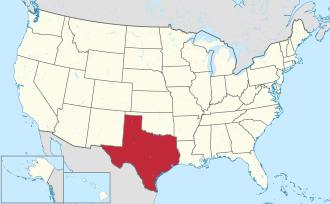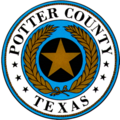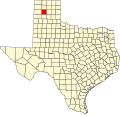Potter County, Texas
 From Wikipedia - Reading time: 12 min
From Wikipedia - Reading time: 12 min
Potter County | |
|---|---|
 Potter County District Courts Building in downtown Amarillo | |
 Location within the U.S. state of Texas | |
 Texas's location within the U.S. | |
| Coordinates: 35°24′N 101°53′W / 35.4°N 101.89°W | |
| Country | |
| State | |
| Founded | 1887 |
| Named after | Robert Potter |
| Seat | Amarillo |
| Largest city | Amarillo |
| Area | |
• Total | 922 sq mi (2,390 km2) |
| • Land | 908 sq mi (2,350 km2) |
| • Water | 14 sq mi (40 km2) 1.5% |
| Population (2020) | |
• Total | 118,525 |
| • Density | 130/sq mi (50/km2) |
| Time zone | UTC−6 (Central) |
| • Summer (DST) | UTC−5 (CDT) |
| Congressional district | 13th |
| Website | www |
Potter County is a county located in the U.S. state of Texas. As of the 2020 census, its population was 118,525.[1] Its county seat is Amarillo.[2] The county was created in 1876 and organized in 1887.[3] It is named for Robert Potter, a politician and signer of the Texas Declaration of Independence and the Texas Secretary of the Navy. Potter County is included in the Amarillo metropolitan area.
History
[edit]LX Ranch
[edit]The LX Ranch was established in the county by W.H. "Deacon" Bates and David T. Beals by 1877. In July 1876, Bates, along with some cowboys, who included Charlie Siringo, established a herd of steers and ranch headquarters along Ranch Creek on the north bank of the Canadian River. The headquarters eventually included a bunkhouse, kitchen, storeroom, stables, corrals, blacksmith shop, wagon sheds, and a post office named Wheeler. The LX also established the county's first cemetery. The ranch eventually extended from Dumas to the Palo Duro Canyon and 35 miles east to west. By 1884, the ranch encompassed 187,000 acres, 45,000 cattle, and 1000 horses, when the operation was sold to the American Pastoral Company. In 1902, the ranch headquarters were moved to Bonita Creek, on the south bank of the Canadian River. On October 6, 1910, that company sold 30,354 acres south of the river to Lee Bivins, and on June 1, 1911, R.B. "Ben" Masterson acquired 89,139 acres on the north side. On May 19, 1915, Bivins bought an additional 53,329 LX acres, which included the LX brand.[4][5][6][7]
Geography
[edit]According to the U.S. Census Bureau, the county has a total area of 922 square miles (2,390 km2), of which 14 square miles (36 km2) (1.5%) are covered by water.[8]
Major highways
[edit]Adjacent counties
[edit]- Moore County (north)
- Hutchinson County (northeast)
- Carson County (east)
- Armstrong County (southeast)
- Randall County (south)
- Deaf Smith County (southwest)
- Oldham County (west)
- Hartley County (northwest)
National protected areas
[edit]Demographics
[edit]| Census | Pop. | Note | %± |
|---|---|---|---|
| 1880 | 28 | — | |
| 1890 | 849 | 2,932.1% | |
| 1900 | 1,820 | 114.4% | |
| 1910 | 12,424 | 582.6% | |
| 1920 | 16,710 | 34.5% | |
| 1930 | 46,080 | 175.8% | |
| 1940 | 54,265 | 17.8% | |
| 1950 | 73,366 | 35.2% | |
| 1960 | 115,580 | 57.5% | |
| 1970 | 90,511 | −21.7% | |
| 1980 | 98,637 | 9.0% | |
| 1990 | 97,874 | −0.8% | |
| 2000 | 113,546 | 16.0% | |
| 2010 | 121,073 | 6.6% | |
| 2020 | 118,525 | −2.1% | |
| U.S. Decennial Census[9] 1850–1900[10] 1910[11] 1920[12] 1930[13] 1940[14] 1950[15] 1960[16] 1970[17] 1980[18] 1990[19] 2000[20] 2010[21] 2020[22] | |||
| Race / Ethnicity (NH = Non-Hispanic) | Pop 2000[23] | Pop 2010[24] | Pop 2020[22] | % 2000 | % 2010 | % 2020 |
|---|---|---|---|---|---|---|
| White alone (NH) | 65,470 | 59,322 | 50,153 | 57.66% | 49.00% | 42.31% |
| Black or African American alone (NH) | 11,047 | 11,823 | 11,999 | 9.73% | 9.77% | 10.12% |
| Native American or Alaska Native alone (NH) | 682 | 602 | 636 | 0.60% | 0.50% | 0.54% |
| Asian alone (NH) | 2,768 | 4,675 | 6,036 | 2.44% | 3.86% | 5.09% |
| Pacific Islander alone (NH) | 27 | 43 | 20 | 0.02% | 0.04% | 0.02% |
| Other race alone (NH) | 86 | 155 | 613 | 0.08% | 0.13% | 0.52% |
| Mixed race or Multiracial (NH) | 1,545 | 1,761 | 3,875 | 1.36% | 1.45% | 3.27% |
| Hispanic or Latino (any race) | 31,921 | 42,692 | 45,193 | 28.11% | 32.56% | 38.13% |
| Total | 113,546 | 121,073 | 118,525 | 100.00% | 100.00% | 100.00% |
As of the census[25] of 2000, 113,546 people, 40,760 households, and 27,472 families were residing in the county. The population density was 125 people per square mile (48 people/km2). The 44,598 housing units had an average density of 49 units per square mile (19 units/km2). The racial makeup of the county was 68.60% White, 9.96% African American, 0.87% Native American, 2.49% Asian, 15.48% from other races, and 2.60% from two or more races. About 28.11% of the population were Hispanics or Latinos of any race.
Of the 40,760 households, 34.7% had children under 18 living with them, 47.4% were married couples living together, 15.0% had a female householder with no husband present, and 32.6% were not families. About 27.6% of all households were made up of individuals, and 10.1% had someone living alone who was 65 or older. The average household size was 2.61, and the average family size was 3.21.
In the county, the age distribution was 28.0% under 18, 11.1% from 18 to 24, 30.1% from 25 to 44, 19.1% from 45 to 64, and 11.7% who were 65 or older. The median age was 32 years. For every 100 females, there were 100.90 males. For every 100 females 18 and over, there were 100.20 males.
The median income for a household in the county was $29,492, and for a family was $35,321. Males had a median income of $26,123 versus $20,275 for females. The per capita income for the county was $14,947. About 15.2% of families and 19.2% of the population were below the poverty line, including 25.3% of those under 18 and 12.3% of those 65 or over.
Government and infrastructure
[edit]The Texas Department of Criminal Justice Clements Unit and Neal Unit are located in unincorporated Potter County, east of the City of Amarillo.[26]
Politics
[edit]Potter County is strongly conservative for an urban county. It has supported Republican presidential candidates in every election since 1968 and all but once since 1952, usually by lopsided margins. Indeed, Jimmy Carter is the last Democrat to reach 40 percent of the vote, and one of only three to do so since Harry Truman. In every election since 1996, the county has given the Republican candidate over two-thirds of its vote.
However, as the county's population has increased, so too has the percentage of Democratic voters. According to the 2020 Election, it is the most Democratic-leaning county in the Texas Panhandle.[27] In 2004, George W. Bush received 21,401 votes (74% of the total) in the county to just 7,489 votes (25%) for his opponent, John Kerry. In 2020, Donald J. Trump received 22,820 votes (69%) in the county as opposed to Joseph R. Biden, who received 9,921 votes (30% of the total). Yet in 2024 Donald Trump received the highest percentage of the vote (over 71%) in the county since Texas favorite George W. Bush in 2004.
| Year | Republican | Democratic | Third party(ies) | |||
|---|---|---|---|---|---|---|
| No. | % | No. | % | No. | % | |
| 2024 | 23,007 | 71.63% | 8,748 | 27.23% | 366 | 1.14% |
| 2020 | 22,820 | 68.45% | 9,921 | 29.76% | 596 | 1.79% |
| 2016 | 19,630 | 68.09% | 7,657 | 26.56% | 1,544 | 5.36% |
| 2012 | 18,918 | 71.52% | 7,126 | 26.94% | 406 | 1.53% |
| 2008 | 20,761 | 69.17% | 8,939 | 29.78% | 313 | 1.04% |
| 2004 | 21,401 | 73.65% | 7,489 | 25.77% | 166 | 0.57% |
| 2000 | 17,629 | 69.47% | 7,242 | 28.54% | 505 | 1.99% |
| 1996 | 14,995 | 57.13% | 9,273 | 35.33% | 1,977 | 7.53% |
| 1992 | 13,510 | 48.64% | 9,527 | 34.30% | 4,738 | 17.06% |
| 1988 | 16,400 | 62.76% | 9,563 | 36.60% | 168 | 0.64% |
| 1984 | 20,396 | 70.57% | 8,365 | 28.94% | 141 | 0.49% |
| 1980 | 16,327 | 60.85% | 9,633 | 35.90% | 871 | 3.25% |
| 1976 | 13,819 | 53.08% | 11,917 | 45.77% | 300 | 1.15% |
| 1972 | 18,891 | 74.56% | 6,264 | 24.72% | 180 | 0.71% |
| 1968 | 13,338 | 49.27% | 8,238 | 30.43% | 5,496 | 20.30% |
| 1964 | 11,505 | 47.11% | 12,850 | 52.62% | 64 | 0.26% |
| 1960 | 14,202 | 61.14% | 8,989 | 38.70% | 38 | 0.16% |
| 1956 | 11,943 | 57.66% | 8,720 | 42.10% | 49 | 0.24% |
| 1952 | 14,931 | 61.62% | 9,259 | 38.21% | 42 | 0.17% |
| 1948 | 4,110 | 28.90% | 9,622 | 67.66% | 490 | 3.45% |
| 1944 | 2,759 | 27.36% | 6,519 | 64.65% | 806 | 7.99% |
| 1940 | 2,285 | 24.02% | 7,203 | 75.71% | 26 | 0.27% |
| 1936 | 1,018 | 13.32% | 6,496 | 84.99% | 129 | 1.69% |
| 1932 | 1,233 | 16.13% | 6,366 | 83.29% | 44 | 0.58% |
| 1928 | 3,627 | 57.90% | 2,637 | 42.10% | 0 | 0.00% |
| 1924 | 831 | 21.81% | 2,394 | 62.82% | 586 | 15.38% |
| 1920 | 358 | 20.21% | 1,374 | 77.58% | 39 | 2.20% |
| 1916 | 166 | 10.65% | 1,288 | 82.62% | 105 | 6.74% |
| 1912 | 41 | 3.86% | 801 | 75.42% | 220 | 20.72% |
| Year | Republican | Democratic | Third party(ies) | |||
|---|---|---|---|---|---|---|
| No. | % | No. | % | No. | % | |
| 2024 | 22,109 | 69.33% | 8,933 | 28.01% | 848 | 2.66% |
Communities
[edit]Cities
[edit]- Amarillo (county seat) (partly in Randall County)
Towns
[edit]Census-designated places
[edit]- Bushland (shared with Randall County)
Unincorporated communities
[edit]Historical communities
[edit]Education
[edit]School districts include:[30]
- Amarillo Independent School District
- Bushland Independent School District
- Highland Park Independent School District
- River Road Independent School District
All of the county is in the service area of Amarillo College.[31]
See also
[edit]- List of museums in the Texas Panhandle
- National Register of Historic Places listings in Potter County, Texas
- Recorded Texas Historic Landmarks in Potter County
References
[edit]- ^ "Potter County, Texas". United States Census Bureau. Retrieved February 23, 2021.
- ^ "Find a County". National Association of Counties. Retrieved June 7, 2011.
- ^ "Texas: Individual County Chronologies". Texas Atlas of Historical County Boundaries. The Newberry Library. 2008. Retrieved May 26, 2015.
- ^ Archer, Jeanne; Taras, Stephanie (2009). Touching Lives: The Lasting Legacy of the Bivins Family. Tell Studios Inc. pp. 45–57. ISBN 9780974914862.
- ^ Pingenot, Ben (1989). Siringo. College Station: Texas A&M University Press. pp. 3–13, 56–58, 121. ISBN 0890963819.
- ^ Siringo, Charles (1885). A Texas Cowboy, Or, Fifteen Years on the Hurricane Deck of a Spanish Pony. Pantianos Classics. pp. 75, 84–86, 96, 101–103, 107, 120, 128. ISBN 9781540575937.
{{cite book}}: ISBN / Date incompatibility (help) - ^ Siringo, Charles (1912). A Cowboy Detective. Arcadia Press. pp. 98–00. ISBN 9781545001882.
{{cite book}}: ISBN / Date incompatibility (help) - ^ "2010 Census Gazetteer Files". United States Census Bureau. August 22, 2012. Retrieved May 6, 2015.
- ^ "Decennial Census by Decade". US Census Bureau.
- ^ "1900 Census of Population - Population of Texas By Counties And Minor Civil Divisions" (PDF). United States Census Bureau.
- ^ "1910 Census of Population - Supplement for Texas" (PDF). United States Census Bureau.
- ^ "1920 Census of Population - Number of Inhabitants - Texas" (PDF). United States Census Bureau.
- ^ "1930 Census of Population - Number of Inhabitants - Texas" (PDF). United States Census Bureau.
- ^ "1940 Census of Population - Number of Inhabitants - Texas" (PDF). United States Census Bureau.
- ^ "1950 Census of Population - Number of Inhabitants - Texas" (PDF). United States Census Bureau.
- ^ "1960 Census of Population - Number of Inhabitants - Texas" (PDF). United States Census Bureau.
- ^ "1970 Census of Population - Number of Inhabitants - Texas" (PDF). United States Census Bureau.
- ^ "1980 Census of Population - Number of Inhabitants - Texas" (PDF). United States Census Bureau.
- ^ "1990 Census of Population - Population and Housing Unit Counts - Texas" (PDF). United States Census Bureau.
- ^ "2000 Census of Population - Population and Housing Unit Counts - Texas" (PDF). United States Census Bureau.
- ^ "2010 Census of Population - Population and Housing Unit Counts - Texas" (PDF). United States Census Bureau.
- ^ a b "P2 Hispanic or Latino, and Not Hispanic or Latino by Race – 2020: DEC Redistricting Data (PL 94-171) – Potter County, Texas". United States Census Bureau.
- ^ "P004: Hispanic or Latino, and Not Hispanic or Latino by Race – 2000: DEC Summary File 1 – Potter County, Texas". United States Census Bureau.
- ^ "P2 Hispanic or Latino, and Not Hispanic or Latino by Race – 2010: DEC Redistricting Data (PL 94-171) – Potter County, Texas". United States Census Bureau.
- ^ "U.S. Census website". United States Census Bureau. Retrieved May 14, 2011.
- ^ "Clements (BC)." Texas Department of Criminal Justice. Retrieved on June 23, 2013. "Unit Address and Phone Number: 9601 Spur 591, Amarillo, TX 79107-9606"
- ^ Texas Secretary of State (November 3, 2020). "Official Canvass Report - 2020 November 3rd General Election" (PDF).
- ^ Leip, David. "Dave Leip's Atlas of U.S. Presidential Elections". uselectionatlas.org. Retrieved July 29, 2018.
- ^ "2024 Senate Election (Official Returns)". Commonwealth of Texas by county. November 5, 2024. Retrieved December 5, 2024.
- ^ "2020 CENSUS - SCHOOL DISTRICT REFERENCE MAP: Potter County, TX" (PDF). U.S. Census Bureau. Archived (PDF) from the original on October 9, 2022. Retrieved June 29, 2022. - list
- ^ Texas Education Code, Sec. 130.164. AMARILLO COLLEGE DISTRICT SERVICE AREA..
 KSF
KSF
